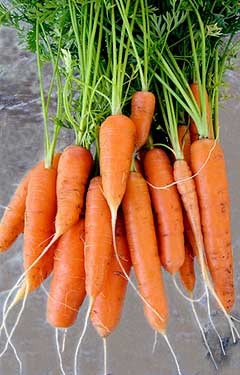PLANT NOTES - VEGETABLES
Carrot
Family: Umbelliferae Genus and Species: Daucus carota sativus
Carrots are easy to grow biennials. Carrots are a cool-season crop, but will tolerate warm temperatures early in the growing season. Night temperatures of 55 degrees and day temperatures of 75 degrees are ideal for carrots.
Carrots do well in all soil types. Several carrots can be left to flower the next season for seed saving. The top can be cut off a carrot, leaving about 1” on the top and planted to provide seeds, rather than leaving the entire carrot in the ground. The flowers are pollinated primarily by bees. Honeybees or mason bees are good carrot pollinators. Carrot seeds store for 3 years under good conditions.
Carrots date back 5000 years. Purple carrots are in drawings from 2000 B.C. Purple, white, red, green/yellow, and black carrots were grown, but orange carrots did not appear until the 15th century.
Planting
Carrots are always direct seeded ¼-½” deep in moist loamy soil with compost to ½” deep. Germinate in temperatures from 50-85° in 6-18 days. Sow seed every inch in rows about 4” apart. When the first leaves appear, carefully thin to 2” apart, then thin to about 4” apart for full sized growth. Carrots can be sown in fall for a late

fall/winter crop, in late winter/early spring for a spring crop, and in late spring for an early summer crop. Sow succession plantings at 2 week intervals. Harvest carrots while young when summer temperatures turn hot.
Cultivation
Hand pick weeds when carrots are small. Weeds take nutrients and moisture and crowd out the slowly emerging carrot tops. Apply mulch when tops are 4” high to keep moist and free of weeds. Carrots grow well in partial sun and need moderate water. Soak soil thoroughly when watering to help promote good root development. Allow soil surface to dry between waterings. Carrots tolerate light frost, but below 50° carrots grow slowly. Above 86° foliage growth is reduced and strong flavors develop. Avoid using raw compost or manure, which will cause forking and hairs. Weeds, rocks and hard clods of soil can also cause carrots to fork.
Harvesting
Maturity is reached in 60-80 days, depending on the variety. Harvest when the roots are of good size, but still tender. Harvest before summer days turn hot. Carrots may be left in the ground during cool winter months. Harvest and store the carrots before a hard freeze. They will continue to sweeten during storage. At maturity, carrots will continue to grow and enlarge, but left too long or allowed to overmature, they may become woody, tough, and cracked.
Companions
Carrots can be interplanted with cabbage, Brussels sprouts and tomatoes, then harvested before the other crops need space. Carrots grow well with beans, lettuce, onions, leeks, chives, radishes, asparagus and celery. Carrots are good for peas, but do not like dill. Carrots grow well with rosemary, sage and parsley, as well as marigolds and nasturtiums.
Commons Attribution 3.0 License